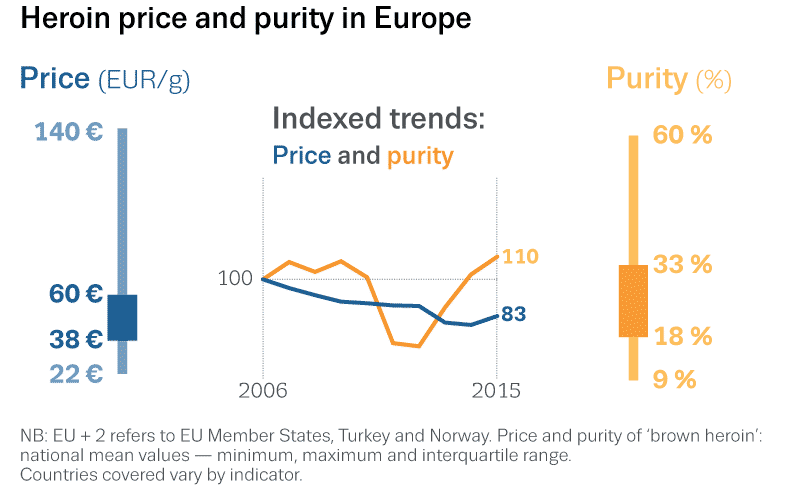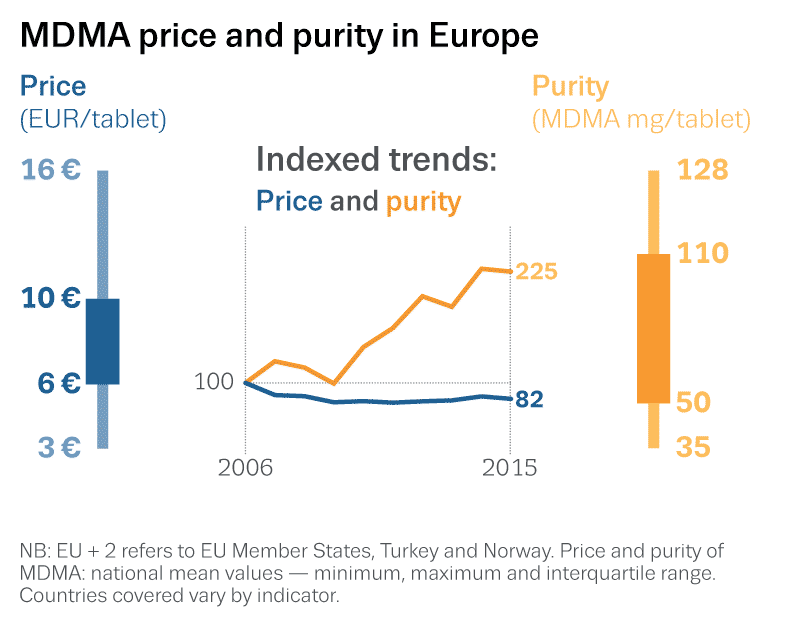Statistical Bulletin 2017 — price, purity and potency
Archived content
Street prices of cannabis, heroin, cocaine and amphetamine are provided in euros per gram, of LSD in euros per unit/dose, and of ecstasy in euros per tablet. Data on prices come from a range of different sources, the comparability of which is not always known. Data on the potency of cannabis products and the purity of heroin (white and brown), cocaine products (cocaine and crack) and amphetamine are presented here. In addition, data on the MDMA content (weight in ecstasy tablets) is provided.
Data tables
Use the menu below to find data sets of interest.
Graphics
Click on a graphic from the thumbnails below
Methods and definitions used
Drug prices
Data on prices come from a range of different sources, the comparability of which is not always known. For example, the type of information systems (police sources, surveys among drug users, etc.) and the sampling strategies used to produce data on the price of illicit drugs at retail level vary considerably across countries.
The data are submitted to the EMCDDA as being national and annual, as well as referring to the retail level of the market. Some caution is, however, required when analysing these data as they might, for some of them, raise representativeness issues. In some cases, they come from local rather than national monitoring systems, and/or from ad hoc non-repeated studies. There is also much uncertainty on the method used to calculate the averages — whether weighted or simple means.
Street prices of cannabis, heroin, cocaine and amphetamine are provided in euros per gram, of LSD in euros per unit/dose, and of ecstasy in euros per tablet. In general, the data on trend in prices has been corrected for inflation rates to allow proper interpretation.
Drug purity/potency
Data on the potency of cannabis products and the purity of heroin (white and brown), cocaine products (cocaine and crack) and amphetamine are presented. In addition, data on the MDMA content (weight) in ecstasy tablets is provided.
The potency of cannabis products is equivalent to the D9-tetrahydrocannabinol (THC) content, where THC is the primary psychoactive constituent in cannabis. It is expressed in percent of THC. Cannabis potency is provided for herbal cannabis and cannabis resin, separately. Whenever possible, a further distinction is made between different types of herbal cannabis; however, caution is required since these distinctions are not always clear in the raw data.
As with data on prices, the data are submitted to the EMCDDA as being national and annual, as well as referring to the retail level of the market. Some caution in relation to representativeness is required when analysing the data, since they may come from local or from ad hoc, non-repeated studies rather than national monitoring systems. Some data are not representative of the retail level and are based on the analysis of all seizures of a drug made and analysed in one country (see part (iii) of the tables for information on this issue). Another source of variation across countries is the type of information systems and the sampling strategies used to produce data on purity/potency. In addition, the way in which ‘average purity/potency’ is calculated is often unclear.
There are analytical difficulties in the precise and accurate determination of the purity/potency of illicit substances; and standards of laboratory analysis might also vary between and within countries.
For more information on cannabis potency see the EMCDDA Insights 6 ‘An overview of cannabis potency in Europe’.
Composition of illicit drug tablets
Data on the contents of illicit drug tablets are presented. Data on the contents of illicit drug tablets provided by the NFPs seeks to monitor synthetic scheduled illicit drugs - i.e. drugs controlled under the 1971 UN Convention on Psychotropic Substances Schedules I and II and under European legislation (Council Decisions) and not medicinal products (diverted from licit manufacture or illegally produced) such as steroids or benzodiazepines, although some pharmaceutical substances might be uncovered when the contents of illicit drug tablets are analysed. The main elements of the data collection comprise combination of contents found in drug tablets analysed: -MDMA-like substances; -(Meth)amphetamine; - MDMA-like substances and (meth)amphetamine & - other scheduled substances.
Most NFPs provide data on the contents of illicit drug tablets from routine statistics and a few countries from ad-hoc studies. Data is based on the results of laboratory analyses, mostly forensic laboratories. Data is provided as being national and annual, as well as referring to seizures or samples provided by users (retail level).
Some caution is, however, required when analysing these data as they might, for some of them, raise representativeness issues. In some cases, come from local or from ad-hoc non-repeated studies rather than national monitoring systems. Some are based on the analysis of tablets seized at different levels of the drug market, while others are, for example, based on the analysis of tablets submitted by users. Indeed, an important source of variation across countries is the type of information systems and the sampling strategies used to produce these data.












